Savage and primitive pagans. Murderers of women and children. A good Indian is a dead Indian. Nineteenth-century white settlers made such opinions about the indigenous peoples of North America. But that was not always the case. The first arrivals from Europe looked at redskins quite differently.
The first contacts between settlers from Europe and the natives did not herald the later tragedy and bloody wars fought in the New World throughout the nineteenth century. The attitudes of both parties were curious and friendly. The Indians eagerly used unfamiliar to them, but intriguing things brought by white people:clothes, firearms, alcohol. The colonists, on the other hand, needed the help of the locals to learn to live in a completely new country.
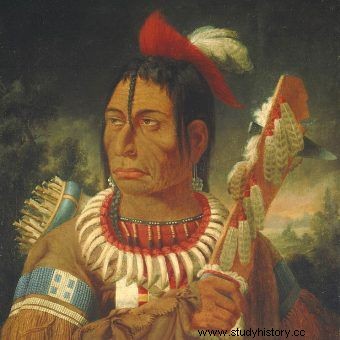
Murderers and pagans? Or maybe… hospitable hosts?
The English Virginia Company, which was organizing the settlement of North America, even instructed its settlers to "make the best possible effort not to offend the natives" . There was also no question of treating them as representatives of an inferior species. After all, it happened that the settlers owed them their lives. This was the case with a group of 102 English Puritans, who in the American tradition are called Pilgrims. Their ship, the Mayflower, landed on Cape Cod on November 11, 1620.
An Indian sent by God
When the newcomers came ashore after a hard journey, they immediately began to penetrate the area in order to find food. It was then that they first found traces of the Indians, or more precisely:the corn stocks they had hidden, which they had taken over. After some time, they decided that the area was not suitable for settlement and moved deeper into the bay. The city they chose to this day is the city they founded - Plymouth. Unfortunately, the living conditions there also turned out to be extremely difficult. Due to the bad climate and diseases, 2-3 people died every day. Half the Pilgrims were dead by the spring of the following year…
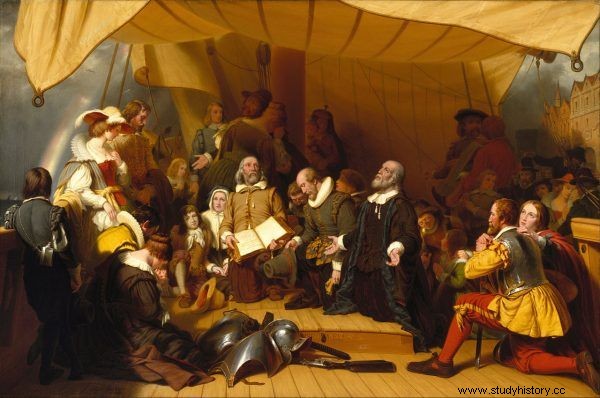
The passengers of the Mayflower did not know what awaited them on the new and unknown land. Picture by Robert Walter Weir.
How were your relations with the indigenous peoples at that time? On March 16, 1621, an unusual event took place in the settlement. An Indian was spotted on one of the nearby hills and approached the buildings without hesitation. When several men barred his way, he greeted them with a gesture and in broken English said: "Welcome Englishmen" or "Hello Englishmen" . His words went down in history.
The newcomer was called Samoset, and he learned the language of the settlers from fishermen coming to this area. He reported that he was sent by the leader of the local Wampanoag tribe - Massasoit. A few days later, he reappeared in the settlement, bringing with him a companion named Squanto who had mastered English much better. The latter willingly took on the role of a translator and intermediary. He fed the eels he gave to the Pilgrims and taught them how to plant corn and how to fertilize barren soil with dead herring.
This significantly improved the situation of the colonizers. “Thanks to Squanto, the corn stolen by the Pilgrims was bountiful, while the imported barley and peas grew poorly in the foreign soil of the New World,” writes Nathaniel Philbrick in Mayflower. A Tale of America's Beginnings ” .
The Indian also brokered the conclusion of the Puritan agreement with the leader Massasoit, in which mutual alliance and support were guaranteed. The leader of the English group, William Bradford, later wrote that Squanto "was a special instrument sent by God for their welfare, though they did not expect it" . He is remembered by the Americans as the savior of the Pilgrims.
Thanksgiving thanks to the Indians
Soon the cooperation of the Pilgrims with the local tribes even flourished. So much so that they invited the Massasoit chief and his warriors to the harvest thanksgiving that was celebrated in the fall. Let's give the floor to Nathaniel Philbrick once more:
(...) Massasoit came to the estate with a hundred Pokanokets (more than twice the size of the entire English population of Plymouth) carrying a freshly hunted deer. Even if the Pilgrims took all their furniture outside, most of the participants would have to stand or squat on the ground around fires, where deer and fowl were roasted on pointed sticks, and with invitingly steaming cauldrons of meat and vegetables.
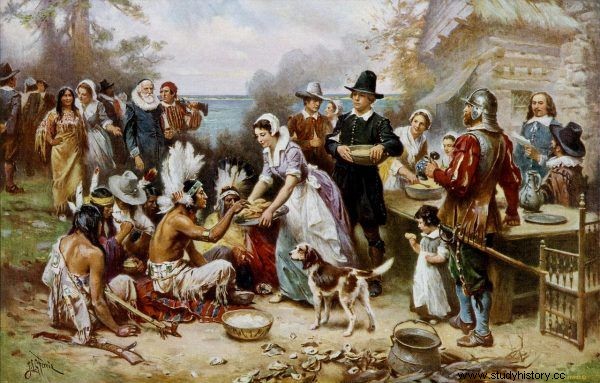
On the first Thanksgiving, the Pilgrims and the Indians organized a feast together.
Hailed as the first Thanksgiving in history, it has passed into American mythology. Over time, it has become one of the most important holidays in this country. And all thanks to the help of the Indians.
Killer or savior Indians?
How good the initial relationship of the whites with the redskins was evidenced by the description of the meeting that took place on Roanoke Island, off the coast of today's North Carolina. Its exploration was undertaken in 1584 by the expedition of captains Philip Amadas and Arthur Barlowe. They encountered local Indians, Kroatans. The contact made was very friendly. The natives received gifts from the English in the form of clothes, and they themselves began to catch the fish they offered to their guests. And this is just the beginning. This is how the party prepared for the sailors was described by the writer and journalist Tony Horwitz:
The local women turned out to be even more hospitable, welcoming the soaked, tired English (...). Indian women [as one of the sailors wrote - ed. ed.] "took our clothes off us and washed them, then dried them again; some of the women took off our stockings and washed them, others washed our feet in warm water ”.
The participants of the expedition (perhaps encouraged by such a warm welcome?) Built a fort and started a new life on the island. Initially, everything went well. The Croatians were eager to teach the newcomers to hunt and fish. Then, however, relations began to deteriorate and the first clashes took place. Soon the Indians stopped supplying the English with food, and the English boarded ships and returned to their homeland.
The island was settled for the second time soon after, in 1587. However, when another expedition reached Roanoke in 1590, it found the settlement completely abandoned. The inhabitants have disappeared. There was no corpse, no sign of a fight. The only clue for the searchers was the word "Croatoan" carved on the palisade. It was suspected that the colonists might have been abducted or died in the ocean trying to reach England.
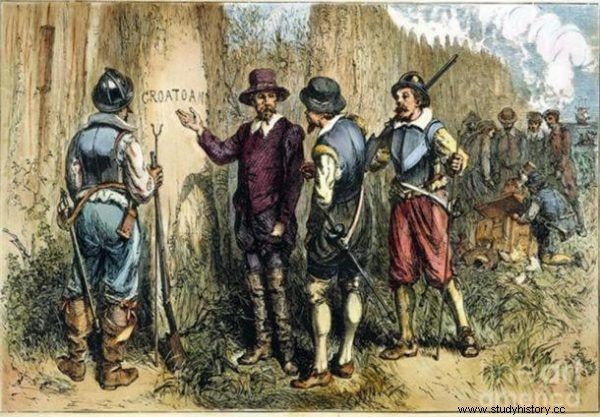
At the end of the 16th century, the colony was completely deserted. The townspeople left behind only one clue - the word "Croatoan" carved on the palisade.
Perhaps the solution to the mystery of the island is completely different? In 2015, British and American archaeologists found English items from the 16th century on Hatteras Island, 110 kilometers from Roanoke. They may have belonged to the inhabitants of the Lost Colony. Scientists suggested that the colonists simply moved to Hatteras due to the difficult living conditions and joined the Indians who lived there.
It seems all the more likely that the island of Hatteras was once called Croatoan and the Kroatan tribe lived on it ... In this case the alleged Indian killers would be rather ... saviors. And their way of life might seem more attractive than European!
Then the miracle happened
There are many more examples of the friendly relations between the first settlers and the Indians. Gestures of friendship and help occurred even when there were disagreements and clashes between the newcomers and the natives. This was the case, for example, in the village of Jamestown in Virginia, where the famous John Smith led. This adventurer and adventurer pursued a firm policy towards the natives from the very beginning. Although he traded with them, he also terrorized them, checking them with firearms and resorting to various tricks.
No wonder that when Smith was finally captured, he was sentenced to death. However, his life was saved by the chief's daughter - Pocahontas, who threw herself at the condemned man and covered him with her own body. The girl became a blessing to the people of Jamestown. She brought them food and even warned them against attacks by her kin. And not only her. Despite mutual hostility, the settlers who found themselves in a dramatic situation received help from the locals.
Jamestown struggled with difficulties from the very beginning. Like the founders of Plymouth described earlier, the people of the colony were dying of disease and starvation. In September 1607, just four months after settling in, most of the first newcomers were already dead, and small rations were only left for a few weeks. They survived only thanks to the help of the indigenous peoples. And they realized it. As Tony Horwitz writes:
Then the miracle happened - the first of several interventions that ultimately saved Jamestown from its inevitable doom. "It pleased God," wrote Percy [one of the colonists - ed. PS], "send here those people who were our mortal enemies, that they may bring relief to us with the help of food, as bread, grain, fish and meat in great abundance, which also saved our weakened people; otherwise we would all die. ”
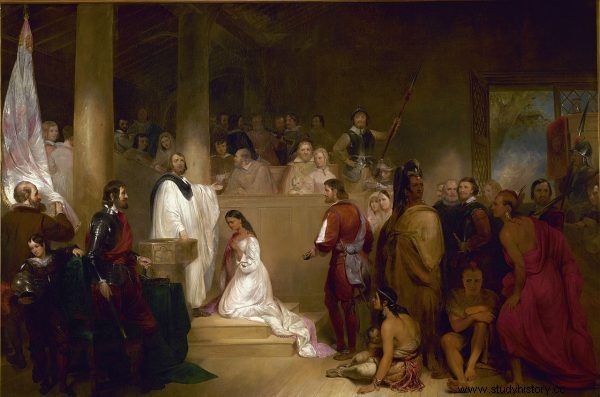
Pocahontas even got baptized, as depicted on the canvas by John Gadsby Chapman.
Peaceful relations were also established on the island of Manhattan, where newcomers from the Netherlands settled in 1624. The Lenape Indians who lived there were kind, eagerly shared their knowledge with guests and exchanged goods. They supplied skins, vegetables and fish, and in return they received woolen clothes and metal tools. The colonists, in turn, were content to trade and cultivate the land. Conquest, taking territory, or converting natives all belonged to the future.
This relatively peaceful coexistence between Europeans and the native peoples of America did not last long. The Indians soon realized that most of the whites wanted to subjugate them and rob them of their land. And since they were not going to give up without a fight, a bloody war began that lasted almost 300 years and ended in their total defeat.
